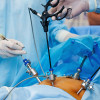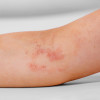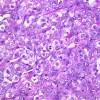
 IJCP Editorial Team
IJCP Editorial Team
Isolated fallopian tube torsion in term pregnancy
A 28-year-old second-gravida, with a history of a previous miscarriage,
was admitted at 37.3 weeks of gestation due to severe abdominal pain. The pain
was acute and occasionally associated with uterine tightness.
The lady had no fever, nausea, vomiting, or prior history of similar
pain. Her menstrual periods were regular before pregnancy, and her antenatal
check-ups were uneventful.
The physical examination revealed that the pain was primarily located in
the right middle abdomen, 2 cm from the umbilicus. She carried a term-sized
uterus, mildly irritable, with a fetus in cephalic presentation and a regular
fetal heart rate of 160 beats/min.
Upon vaginal examination, she was 1 cm dilated with 40% effacement and
the vertex at -3 station, indicative of early labor. The admission hematocrit
was 32%, with a TLC of 13,000/mm3 and 80% neutrophils. No abnormalities were
detected in the urine.
As she progressed into labor, fetal distress emerged, leading to
emergency lower segment cesarean section (LSCS). During the procedure, a 6x3 cm
gangrenous, necrosed, and congested right fallopian tube was discovered, along
with mild hydrosalpinx. Post-delivery, the uterus was closed, and a
salpingectomy was performed due to the unsalvageable condition of the tube. The
left fallopian tube, both ovaries and the appendix showed no abnormalities.
Histological examination revealed recent congestion, necrosis, and
hemorrhage in the fallopian tube wall, indicative of torsion. The postoperative
period was uneventful, and the patient was discharged on the 3rd postoperative
day with a subsequent uneventful follow-up.
While torsion of the fallopian tube in pregnancy is rare, it should be considered as the differential diagnosis of acute abdomen. Imaging techniques, although suggestive, may not be confirmatory. In cases where ultrasound does not confirm the diagnosis, MRI can aid in establishing an accurate diagnosis. Early diagnosis is crucial for preserving the tube, but it remains challenging due to the nonspecific nature of symptoms.
Source: Tyagi S. New Indian J of OBGYN. 2023;10(1)

IJCP Editorial Team
Comprising seasoned professionals and experts from the medical field, the IJCP editorial team is dedicated to delivering timely and accurate content and thriving to provide attention-grabbing information for the readers. What sets them apart are their diverse expertise, spanning academia, research, and clinical practice, and their dedication to upholding the highest standards of quality and integrity. With a wealth of experience and a commitment to excellence, the IJCP editorial team strives to provide valuable perspectives, the latest trends, and in-depth analyses across various medical domains, all in a way that keeps you interested and engaged.












Please login to comment on this article